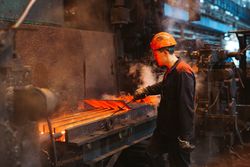The History of Steel Production in the United States

Steel can be found everywhere. It is in our kitchen appliances, industrial buildings, and in our vehicles. This alloy of carbon is an important part of everyday life. According to the National Mining Association, every American will use 27,416 pounds of iron to maintain the current standard of living in the United States. This includes having safe cars to drive, sustainable buildings, sturdy roads and bridges, and modern conveniences such as laptops and smartphones. Though this metal is an essential part of American life, it wasn’t always this way. Below, learn how steel production became an integral part of life in America.
The Early Years
The production of this metal predates the settlers that first came to the United States. For the early colonists, steel was an important component for survival as it allowed them to make tools such as hammers and axes for building structures and mechanisms for hunting and planting crops. Prior to the 1840s, this important metal was made from iron and coal. While iron deposits were easy to come by, coal presented some challenges. As the substance required more coal than iron, colonists began to move inward from coastal areas in search of locations where both ingredients were easily accessible. This made places like Pennsylvania, with its abundance of coal deposits and iron ore, ideal locations for production.
The Revolution of Steel Making in America
The production process encountered changes quickly in the early years on the American frontier. In 1840, coal was replaced with “coke,” a substance derived from heating coal or oil, as the duel and reducing agent. In 1864, the Bessemer Process came to America, which allowed for faster mass production. The industry boomed following the Civil War. From the 1880s to 1900, the American steel industry was the largest in the world as production increased from 1.25 million tons produced annually to over 10 million. In 1910, that number jumped to 24 million tons.
This industry played a large role in the war efforts, and even after World War II, the industry continued to thrive as infrastructure expanded with technological advancements in appliances and vehicles.
Steel Production Today
 Though the industry peaked in 1969 at 141,262,000 tons, it’s still a major industry. The United States is the largest importer of this metal, and Americans are more reliant on it than ever. There have been significant advancements in the material’s strength. Advanced high-strength steel is a lightweight, low emission material that is essential for the newer, safer cars on the road. Advancements such as these keep this industry efficient, sustainable, and well-equipped to keep up with modern technology.
Though the industry peaked in 1969 at 141,262,000 tons, it’s still a major industry. The United States is the largest importer of this metal, and Americans are more reliant on it than ever. There have been significant advancements in the material’s strength. Advanced high-strength steel is a lightweight, low emission material that is essential for the newer, safer cars on the road. Advancements such as these keep this industry efficient, sustainable, and well-equipped to keep up with modern technology.
Whether you’re in need of a steel surplus or a place to recycle this popular metal material, David Hirschberg Steel & Recycling Center in Cincinnati, OH, is your one-stop destination. For over 100 years, they’ve been committed to providing quality materials and outstanding customer service. Visit them online to view their inventory and learn about their services. Call them today at (513) 821-0514 to find out more information.
About the Business
Have a question? Ask the experts!
Send your question

